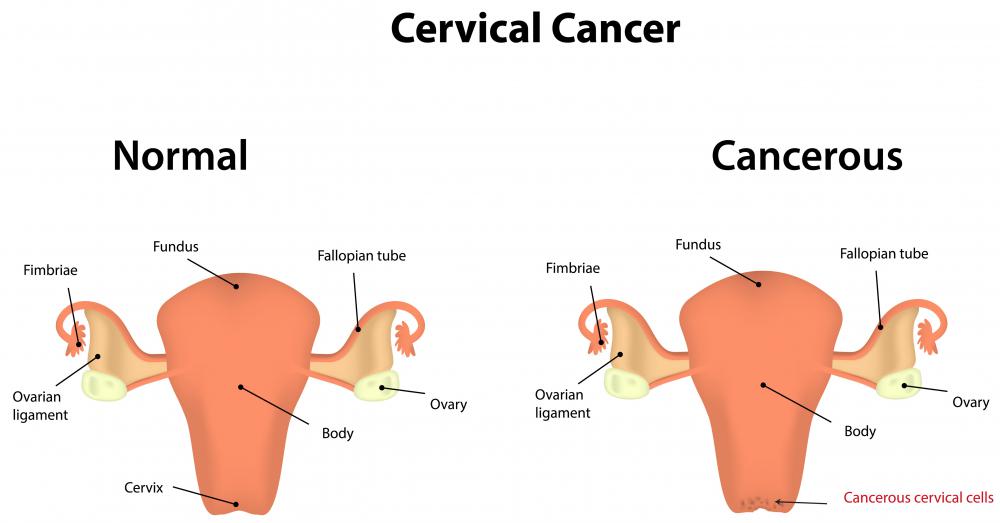At TheHealthBoard, we're committed to delivering accurate, trustworthy information. Our expert-authored content is rigorously fact-checked and sourced from credible authorities. Discover how we uphold the highest standards in providing you with reliable knowledge.
What is a Cervical Biopsy?
The cervical biopsy is a surgical procedure, where a small amount of tissue is removed from the cervix. This test is completed to collect a tissue sample and test for cancerous or precancerous cells. The cervix is the canal between the uterus and the vagina. A biopsy is the actual process of removing sample tissue from the patient.
There are three types of cervical biopsy procedures: punch, cone, and endocervical curettage (ECC). All three must be performed by a certified medical doctor but can be completed either in the doctor’s office or in a hospital outpatient clinic. A local anesthetic may be used, if required.

A punch biopsy uses a small tool that pinches the tissue and removes a round sample. It is quite common to collect two or three samples from different areas of the cervix when using this type of biopsy, as the sample is very localized. The cone biopsy uses a laser to remove a complete layer of tissue from the surface of the cervix. The entire cervix is sampled with this technique, providing enough material to test for any cancerous or precancerous cells.

In an endocervical curettage process, the curette is inserted into the cervix and is used to scrape the lining of the endocervical canal. This area is inside the cervix and is not available for a visual inspection. The curette is a narrow instrument used to scrape and collect tissue samples.
The purpose of a cervical biopsy is to detect cancer or precancerous lesions, polyps, or genital warts. This test is usually ordered after a pelvic examination or pap test, where abnormal cells are found. A pelvic exam or pap test is a standard medical exam completed every one to three years to identify cancer or changes to the reproductive system.

Any cells that have an abnormal shape are considered precancerous. This term is used to describe cells that are not yet cancerous, but are not normal shape and size. Cancer is the growth and development of cells that are not the correct shape and size. Abnormal cell development is fairly common, but these cells usually die very quickly. Abnormal cells that are able to sustain themselves and multiply are considered cancer cells.
A cervical biopsy is a nerve-racking procedure. Possible complications from this surgery include infections and bleeding. If you are pregnant, or may be pregnant, inform your doctor, as this affects the type of cervical biopsy that can be done.
AS FEATURED ON:
AS FEATURED ON:

















Discussion Comments
@sunnySkys - Glad your friend is okay now. I'm actually supposed to have a cervical biopsy next week, so I've been doing a little bit of reading on the topic.
I'm pretty nervous about it, especially because of the possible complications. Luckily, I'm not pregnant or in otherwise ill health. I'm a little worried about the possibility of infection, but I'm going to make it a big point to take extra good care of myself before the biopsy and take extra vitamin C!
@MissDaphne - Sorry, but to recommend young women only get a pap smear every few years (against medical advice even) is just irresponsible. I plan to continue getting my annual pap until my doctor tells me it isn't necessary.
I've actually had a few friends that have had to have cervical biopsies because of the dreaded "abnormal pap." One of them actually did have cancer. She's fine now, but the biopsy was just the beginning of the medical procedures for her.
Normally, if they find cancerous cells in a biopsy, the next step is surgery to remove the cancer. In my friends case, they removed one of her ovaries and part of the other one. She didn't need chemotherapy, but some people do after that.
@MissDaphne - I was always in the "better safe than sorry" camp; my doctor did a Pap test every year and I never thought to question him.
Then my best friend, who has HPV, had an abnormal Pap. She wound up having a cervical cone biopsy with bleeding afterwards. It sounded so painful and unpleasant!
Now for her, because she has HPV, the testing is really important. Thank goodness she turns out to be all right. But it did make me think about over-testing.
Naturally, she's done a lot of research into cervical cancer because she's at such high risk. It's so very slow-growing that for most women, a Pap every two or three years is quite adequate. It's not something that's going to go from zero to sixty in just a few months.
It's so very hard for us mere mortals to know how much testing is too much and how much is not enough! We all want to be healthy.
The complications of a cervical biopsy are, counterintuitively, why it might *not* be good to have too many Pap smears.
Many people think that it's better to be safe than sorry and want to have as many tests as possible. But your body can sometimes get rid of problems on its own, plus there's always the chance of a false positive.
More tests equals more biopsies equals more possible complications, especially if you plan to become pregnant. The cervical cone biopsy can be particularly problematic during pregnancy; it increases your chance of having an incompetent cervix and also interferes with your production of cervical fluid. Let's *end* the annual Pap smear for healthy women!
Post your comments